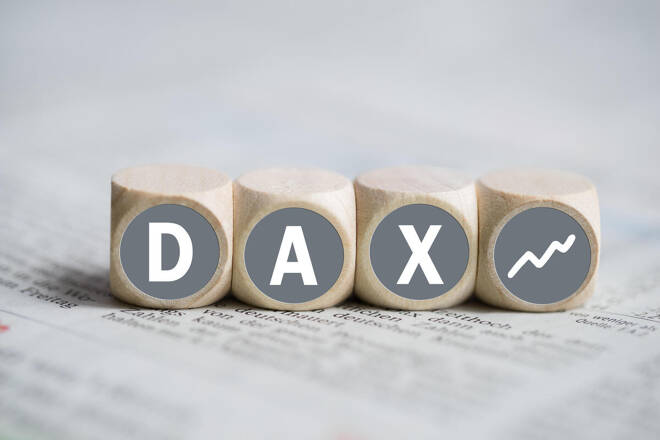Advertisement
Advertisement
DAX in the Hands of China Economy Jitters and US Retail Sales
By:
It is a quiet day ahead for the DAX, with no economic indicators from the euro area to draw interest. Sentiment toward China will remain an influence.
Highlights
- It was a bearish start to the week for the DAX on Monday, falling 0.23% to end the day at 16,069.
- Economic indicators from China spooked investors as the focus shifted from monetary policy to the global economy.
- Looking toward today’s session, a quiet economic calendar leaves US retail sales to move the dial.
It was a bearish Monday session for the DAX, which fell 0.23%. Following a 0.22% loss on Friday, the DAX ended the day at 16,069. Despite the bearish session, the DAX wrapped up the day at 16,000 for the fourth consecutive session.
Economic indicators from China failed to calm investor nerves over the rising threat of a global economic recession.
The Chinese economy expanded by 0.8% in the second quarter and by 6.3% year-over-year. Economists forecast the Chinese economy to grow by 7.3% year-over-year but by just 0.5% in the second quarter.
While the economy grew more than anticipated in Q2, the year-on-year figure was the focal point as China sees the post-zero-COVID policy reboot splutter.
Economic indicators from the US failed to move the dial, with the markets facing uncertainty as the Fed entered the blackout period on July 15.
The NASDAQ Composite Index gained 0.93%, with the Dow and the S&P 500 rising by 0.22% and 0.39%, respectively. Investor hopes of better than forecast earnings results and favorable outlooks provided Monday support.
Investors Ignore Italian Inflation and US Manufacturing Numbers
It was a quiet day on the European economic calendar. Italian inflation numbers failed to deliver support, with finalized numbers aligned with prelim figures. The annual inflation rate softened from 7.6% to 6.4% in June.
US economic indicators also failed to distract investors from the China stats. The NY Empire State Manufacturing Index fell from 6.60 to 1.10 in July versus a forecasted decline to -4.30.
While input and factory gate price pressures continued to ease, the outlook on CAPEX remained weak, reflecting manufacturing sector conditions.
The Market Movers
It was a mixed session for the auto sector. Porsche and Volkswagen saw losses of 0.71% and 0.89%, respectively, with Continental AG falling by 0.40%. BMW and Mercedes-Benz Group ended the day up 0.04% and 0.12%, respectively.
However, it was a bullish session for the banks. Commerzbank and Deutsche Bank saw gains of 0.77% and 2.36%, respectively. Deutsche Bank was the best performer on the day.
The Day Ahead for the DAX
There are no economic indicators from the euro area for investors to consider today. The lack of euro area economic indicators will leave China’s woes to test investor sentiment ahead of the US session.
However, ECB commentary will need consideration. ECB Executive Board Member Fabio Panetta is on the calendar to speak today. Investors are looking for post-summer forward guidance.
It is a busier day on the US economic calendar. Retail sales, industrial production, and business inventory numbers are in focus. However, we expect the US retail sales figures to have the most impact.
With no FOMC members speaking because of the blackout period, an unexpected spike in spending should support bets on a soft landing. Economists forecast retail sales to increase 0.5% in June versus a 0.3% increase in May.
DAX Technical Indicators
Looking at the EMAs and the 4-hourly chart, the EMAs sent bullish signals. The DAX sat above the 50-day (15,956) and 200-day (15,852) EMAs, signaling bullish momentum over the near and longer term. Significantly, the 50-day EMA pulled further away from the 200-day EMA, sending bullish signals and supporting a move through the upper level of the 16,000 – 16,080 resistance band.
A move through the upper level of the 16,000 – 16,080 resistance band would bring the July high of 16,209 into play. However, US economic indicators must be DAX-friendly to support a bullish session.
A fall through the lower level of the 16,000 – 16,080 resistance band would bring the 50-day EMA (15,956) into view.
The 14-4H RSI sits at 59.28, sending bullish signals. Significantly, the RSI aligns with the EMAs, supporting a breakout from the resistance band to target the July high of 16,209.
For a look at the economic events, check out our economic calendar.
About the Author
Bob Masonauthor
With over 28 years of experience in the financial industry, Bob has worked with various global rating agencies and multinational banks. Currently he is covering currencies, commodities, alternative asset classes and global equities, focusing mostly on European and Asian markets.
Advertisement
